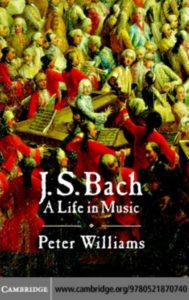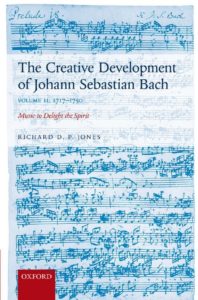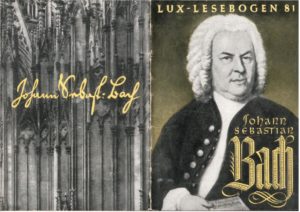- The 100 most inspiring musicians of all time: JOHANN SEBASTIAN BACH
- Johann Sebastian Bach(b. March 21, 1685, Eisenach, Thuringia, Ernestine Saxon Duchies [Germany]—d. July 28, 1750, Leipzig)
- Bach – Chromatic Fantasia and Fugue in D minor BWV 903 with sheet music
- Download Bach’s best sheet music from our Library.
The 100 most inspiring musicians of all time: JOHANN SEBASTIAN BACH
Browse in the Library:
and subscribe to our social channels for news and music updates:
Johann Sebastian Bach
(b. March 21, 1685, Eisenach, Thuringia, Ernestine Saxon Duchies [Germany]—d. July 28, 1750, Leipzig)
A prolific composer of the Baroque era, Johann Sebastian Bach was the most celebrated member of a large family of northern German musicians. Although he was admired by his contemporaries primarily as an outstanding harpsichordist, organist, and expert on organ building, Bach is now generally regarded as one of the greatest composers of all time and is celebrated as the creator of the Brandenburg Concertos, The Well-Tempered Clavier, the Mass in B Minor, and numerous other masterpieces of church and instrumental music.

Early Years
J.S. Bach was the youngest child of Johann Ambrosius Bach and Elisabeth Lämmerhirt. Ambrosius was a string player, employed by the town council and the ducal court of Eisenach. Although Johann Sebastian started school in 1692 or 1693, nothing definite is known of his musical education at that time. By 1695 both his parents were dead, and he was looked after by his eldest brother, Johann Christoph (1671–1721). Christoph was the organist at Ohrdruf, and he apparently gave Johann Sebastian his first formal keyboard lessons. In 1700 the young Bach secured a place in a select choir of poor boys at the school at Michaelskirche, Lüneburg.
Bach evidently returned to Thuringia late in the summer of 1702, already a reasonably proficient organist and composer of keyboard and sacred music. By March 4, 1703, he was a member of the orchestra employed by Johann Ernst, duke of Weimar (and brother of Wilhelm Ernst, whose service Bach entered in 1708). When the new organ was completed at the Neue Kirche (New Church) in Arnstadt, on the northern edge of the Thuringian Forest, Bach helped test it, and in August 1703 he was appointed organist—at age 18.
The Arnstadt Period
At Arnstadt, where he remained until 1707, Bach devoted himself to keyboard music, for the organ in particular. In October 1705 he obtained a month’s leave to walk to Lübeck (more than 200 miles [300 km]), with the specific intention of becoming acquainted with the spectacular organ playing and compositions of Dietrich Buxtehude. He did not return to Arnstadt until mid-January 1706.
During these early years, Bach inherited the musical culture of the Thuringian area, a thorough familiarity with the traditional forms and hymns (chorales) of the orthodox Lutheran service, and, in keyboard music, perhaps a bias toward the formalistic styles of the south. But he also learned eagerly from the northern rhapsodists, Buxtehude above all. By 1708 he had arrived at a first synthesis of northern and southern German styles.
Among the works that can be ascribed to these early years are the Capriccio sopra la lontananza del suo fratello dilettissimo (1704; Capriccio on the Departure of His Most Beloved Brother, BWV 992), the chorale prelude on Wie schön leuchtet (c. 1705; How Brightly Shines, BWV 739), and the fragmentary early version of the organ Prelude and Fugue in G Minor (before 1707, BWV 535a). (The “BWV” numbers provided are the standard catalog numbers of Bach’s works as established in the Bach-Werke-Verzeichnis, prepared by the German musicologist Wolfgang Schmieder).
The Mühlhausen Period
In June 1707 Bach obtained a post at the Blasiuskirche in Mühlhausen in Thuringia. He moved there soon after and married his cousin Maria Barbara Bach at Dornheim on October 17. At Mühlhausen he produced several church cantatas; all of these works are cast in a conservative mold, based on biblical and chorale texts. The famous organ Toccata and Fugue in D Minor (BWV 565), written in the rhapsodic northern style, and the Prelude and Fugue in D Major (BWV 532) may also have been composed during the Mühlhausen period, as well as the organ Passacaglia in C Minor (BWV 582), an early example of Bach’s instinct for large-scale Organization. Cantata No. 71, Gott ist mein König (God Is My King), of Feb. 4, 1708, was the first of Bach’s compositions to be published. Bach resigned from his post in Mühlhausen on June 25, 1708, and subsequently moved to Weimar, on the Ilm River.
The Weimar Period
Bach was, from the outset, court organist at Weimar and a member of the orchestra. From Weimar, he occasionally visited Weissenfels, and in February 1713 he took part in a court celebration there that included a performance of his first secular cantata, Was mir behagt, also called the Hunt Cantata (BWV 208). On March 2, 1714, Bach became the concertmaster at Weimar; as such, he was charged with composing a cantata every month.
Bach’s development cannot be traced in detail during the vital years 1708–14, when his style underwent a profound change. From the series of cantatas written in 1714–16, however, it is obvious that he had been decisively influ-enced by the new styles and forms of the contemporary Italian opera and by the innovations of such Italian con-certo composers as Antonio Vivaldi. His favourite forms appropriated from the Italians were those based on refrain (ritornello) or da capo schemes in which wholesale repetition—literal or with modifications—of entire sections of a piece permitted him to create coherent musical forms with much larger dimensions than had hitherto been possible. These newly acquired techniques hence-forth governed a host of Bach’s arias and concerto movements, as well as many of his larger fugues; they also profoundly affected his treatment of chorales.
Among other works likely composed at Weimar are most of the Orgelbüchlein (Little Organ Book), all but the last of the so-called 18 “Great” chorale preludes, the earliest organ trios, and most of the organ preludes and fugues. The “Great” Prelude and Fugue in G Major for organ (BWV 541) was finally revised about 1715, and the Toccata and Fugue in F Major (BWV 540) may have been played at Weissenfels.
The Köthen Period
Late in 1717 Bach left Weimar to begin his new appoint-ment as musical director to Prince Leopold of Köthen. In Köthen, Bach was concerned chiefly with chamber and orchestral music, and it was there that the sonatas for violin and clavier and for viola da gamba and clavier and the works for unaccompanied violin and cello were put into something like their present form.
The Brandenburg Concertos were finished by March 24, 1721. Bach also found time to complete several cantatas as well as compile pedagogical keyboard works, including the Clavierbüchlein for W.F. Bach (begun Jan. 22, 1720), some of the French Suites, the Inventions (1720), and the first book (1722) of Das Wohltemperierte Klavier (The Well-Tempered Clavier), a work that eventually consisted of two books, each of 24 preludes and fugues in all keys. The remarkable col-lection of “well-tempered” compositions systematically explores both the potentials of a newly established tuning procedure—which, for the first time in the history of keyboard music, made all the keys equally usable—and the possibilities for musical organization afforded by the system of “functional tonality,” a kind of musical syntax consolidated in the music of the Italian concerto com-posers of the preceding generation and a system that was to prevail for the next 200 years.
At the same time, The Well-Tempered Clavier is a compendium of the most pop-ular forms and styles of the era: dance types, arias, motets, concerti, etc., presented within the unified aspect of a single compositional technique—the rigorously logical and venerable fugue.
Maria Barbara Bach died unexpectedly in 1720, and Bach married Anna Magdalena Wilcken, daughter of a trumpeter at Weissenfels, on Dec. 3, 1721. Apart from his first wife’s death, Bach’s first few years at Köthen were probably the happiest of his life, and he was on the best terms with the prince. But after the prince got married—to an apparently antimusical and demanding woman—Bach began to feel neglected. At the same time, he began to consider the education of his elder sons, born in 1710 and 1714, and his thoughts turned to Leipzig. On Feb. 7, 1723, Bach gave a trial performance in Leipzig in application for the position of cantor, which had been vacated some months earlier by the death of Johann Kuhnau. Bach received the appointment, was granted permission to leave Köthen, and was installed in his new position on May 13.

Years at Leipzig
As director of church music for the city of Leipzig, Bach had to supply performers for four churches: Peterskirche, Neue Kirche, Nikolaikirche, and Thomaskirche. His first official performance was on May 30, 1723 with Cantata No. 75, Die Elenden sollen essen. New works produced during this year include many cantatas and the Magnificat in its first version. The first half of 1724 saw the produc-tion of the St. John Passion, which was subsequently revised. The total number of cantatas produced during this ecclesiastical year was about 62, of which about 39 were new works.
On June 11, 1724, Bach began a fresh annual cycle of cantatas, and within the year he wrote 52 of the so-called chorale cantatas. Indeed, during his first two or three years at Leipzig, Bach produced a large number of new cantatas, sometimes at the rate of one a week. The hectic pace of production required Bach (and other Baroque composers) to invent or discover their ideas quickly; they could not rely on the unpredictable arrival of “inspiration.” Consequently, the typical Baroque composer had to be a traditionalist who readily embraced the musical conventions and techniques of the time.
Symbolism
A repertoire of melody types existed, for example, that was generated by an explicit “doctrine of figures” that created musical equivalents for the figures of speech in the art of rhetoric. Closely related to these “figures” are such examples of pictorial symbolism in which the com-poser writes, say, a rising scale to match words that speak of rising from the dead or a descending chromatic scale (depicting a howl of pain) to sorrowful words. Pictorial symbolism of this kind occurs only in connection with words—in vocal music and in chorale preludes, where the words of the chorale are in the listener’s mind.
Number symbolism, another common device of the Baroque period, also is sometimes pictorial; in the St. Matthew Passion, for instance, it is reasonable that the question “Lord, is it I?” should be asked 11 times, once by each of the faithful disciples. The Baroque composer had at his disposal various other formulas for elaborating themes into com-plete compositions; skilled use of such formulas allowed the arias and choruses of a cantata to be spun out almost “automatically.”
As a result of his intense activity in cantata production during his first three years in Leipzig, Bach had created a supply of church music to meet his future needs for the regular Sunday and feast day services. After 1726, therefore, he turned his attention to other projects. He did, however, produce the St. Matthew Passion in 1729, a work that inaugurated a renewed interest in the mid-1730s for vocal works on a larger scale than the cantata; the now-lost St. Mark Passion (1731); the Christmas Oratorio, BWV 248 (1734); and the Ascension Oratorio (Cantata No. 11, Lobet Gott in seinen Reichen; 1735).
Instrumental Works
In 1726, after he had completed the bulk of his cantata production, Bach began to publish the clavier Partitas singly, with a collected edition in 1731. The second part of the Clavierübung, containing the Concerto in the Italian Style and the French Overture (Partita) in B Minor, appeared in 1735. The third part, consisting of the Organ Mass with the Prelude and Fugue [“St. Anne”] in E-flat Major (BWV 552), appeared in 1739. From c. 1729 to 1736 Bach was honorary musical director to Weissenfels; and, from 1729 to 1737 and again from 1739 for a year or two, he directed the Leipzig Collegium Musicum. For these concerts, he adapted some of his earlier concerti as harpsichord con-certi, thus becoming one of the first composers—if not the very first—of concerti for keyboard instrument and orchestra.
About 1733 Bach began to produce cantatas in honour of the elector of Saxony and his family, evidently with a view to the court appointment he secured in 1736; many of these secular movements were adapted to sacred words and reused in the Christmas Oratorio. The Kyrie and Gloria of the Mass in B Minor, written in 1733, were also dedicated to the elector, but the rest of the Mass was not put together until Bach’s last years. On his visits to Dresden, Bach had won the regard of the Russian envoy, Hermann Karl, Reichsgraf (count) von Keyserlingk, who commissioned the so-called Goldberg Variations; these were published as part four of the Clavierübung about 1742, and Book Two of Das Wohltemperierte Klavier seems to have been compiled about the same time. In addition, he wrote a few cantatas, revised some of his Weimar organ works, and published the so-called Schübler Chorale Preludes in or after 1746.

Last Years
In May 1747 Bach visited his son (Carl Philipp) Emanuel at Potsdam and played before Frederick II the Great of Prussia. In July his improvisations, on a theme proposed by the king, took shape as The Musical Offering. In June 1747 he joined a Society of the Musical Sciences, to which he presented the canonic variations on the chorale Vom Himmel hoch da komm’ ich her (From Heaven Above to Earth I Come).
Of Bach’s last illness little is known except that it lasted several months and prevented him from finishing The Art of the Fugue; he succumbed to his illness on July 28, 1750, at Leipzig. Anna Magdalena was left badly off. Her stepsons apparently did nothing to help her, and her own sons were too young to do so. She died on Feb. 27, 1760, and was given a pauper’s funeral. Unfinished as it was, The Art of the Fugue was published in 1751 and was reissued in 1752. Very few copies were sold, however.